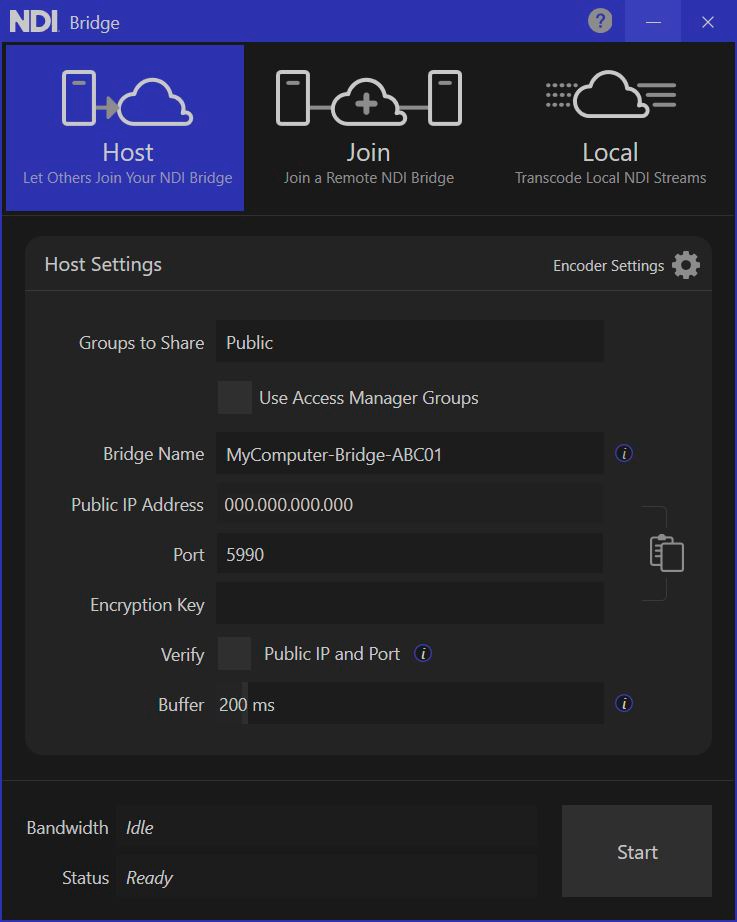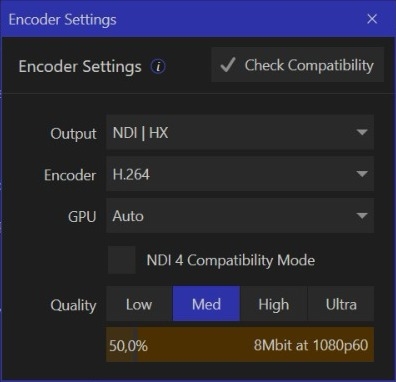Bridge
Simplify Remote NDI Workflows.
NDI Bridge enables the interconnection of remote NDI infrastructures, incorporating multipoint capabilities. It delivers local convenience on a global scale as it handles all the complexity of remote sources, supporting all of the benefits of NDI, including:
Video Transcoding for transmitting streams over the internet using H.264 or HEVC compression
Alpha channel support (due to h.264 compression's resolution limitations, it is only possible to use HD resolution with an alpha channel or UHD without it. HEVC supports all reasonable resolutions with and without alpha)
Multichannel audio support
PTZ controls
Tally support
KVM (Keyboard, Video, Mouse) support
Custom metadata
This system is comprised of three key components:
Host Mode

In Host mode, you can configure the following settings:
Groups to Share: Share specific NDI Groups defined in the NDI local network by the NDI Access Managers.
Bridge Name: Define a specific name for the connected bridge system. This name helps to identify the sources shared through a remote Bridge.
The Bridge Name specified must be unique.
Server IP Address: This field is automatically populated by default on Bridge startup; the application automatically discovers the public IP address of the wan connection. However, NDI Bridge Host/Join can be used inside a local area network or over an existing VPN; a local Bridge Join can connect to a local Host using the physical Host IP Address.
Port: Define the network port used by the remote Bridge Join to establish the connection with the Host through a port forwarding (NAT).
Encryption Key: Encryption ensures that only authorized parties can access the connection and data transmission between Bridge applications.
The strength of the key, determined by its length and complexity, is crucial to the security of the encrypted data.
Resolve Public IP and Port: This option allows the Bridge Application to automatically find and verify the public IP address and the port forwarding configuration.
Buffer: The buffer setting in NDI Bridge is a configurable option that determines the amount of video data the system temporarily stores (or buffers) during transmission. This setting helps manage the data flow and can improve the stability of the video stream, especially over networks with varying latency or bandwidth. By adjusting the buffer, you can find a compromise between lower latency and smoother video playback, depending on the network conditions and performance requirements.
Encoder Settings
Adjust encoder settings to define how signals are shared across the wide-area network.

Check Compatibility: Verifies if the system can support h.264 and h.265 (HEVC) encoding and decoding.
Output: Configure how NDI Bridge manages the stream transcoding:
NDI HX
H.264 or HEVC
Opus (Max. 255 audio ch per stream)
NDI High Bandwidth
SpeedHQ
Passthrough PCM Uncompressed
Do Not Transcode
N/A
Opus (Max. 255 audio ch per stream)
Join mode
Through Join mode, you can connect your local NDI network to a remote Host. On the menu, you can configure the following settings:
Groups to Share: Share specific NDI Groups defined in the NDI local network by the NDI Access Managers.
Bridge Name: Define a specific name for the connected bridge system. This name helps to identify the sources shared through a remote Bridge.
The Bridge Name specified must be unique.
Server IP Address: define the public IP address of the remote Bridge Host.
Port: Define the network port used by the remote Bridge Join to establish the connection with the Host through a port forwarding (NAT).
Encryption Key: Encryption ensures that only authorized parties can access the connection and data transmission between Bridge applications.
The strength of the key, determined by its length and complexity, is crucial to the security of the encrypted data.
Resolve Public IP and Port: This option allows the Bridge Application to automatically find and verify the public IP address and the port forwarding configuration.
Buffer: The NDI Bridge buffer setting is a configurable option that determines the amount of video data the system temporarily stores (or buffers) during transmission. This setting helps manage the data flow and can improve the stability of the video stream, especially over networks with varying latency or bandwidth. By adjusting the buffer, you can find a compromise between lower latency and smoother video playback, depending on the network conditions and performance requirements.
Using NDI Bridge Locally
NDI Bridge can be used inside a local area network using the Local mode for the following use cases:
Transcoding NDI High Bandwidth to NDI HX, which can be useful for distributing NDI streams with a lighter codec (h.264 or h.265).
Unicast repeater: By default, NDI transmitters use unicast, and the network interface's capacity limits their output capability. When an NDI stream needs to be shared with multiple receivers, NDI Bridge can be employed to leverage a larger network capacity by using Bridge in local mode. In the encoding settings, the "Do Not Transcode" option can be selected. This allows the NDI Bridge to replicate the requested stream to multiple receivers, overcoming the limited unicast capacity of the original NDI transmitter.
Here's how to configure Local Mode:
Select the Local tab.
Enter the NDI Access Manager groups and bridge name.
Adjust the Encoder Settings.
Click Start to activate the NDI Bridge in Local mode.
An NDI Bridge executable can also be launched using the following command line arguments.
Troubleshooting
To troubleshoot common issues hover your cursor over the yellow exclamation point for a tool tip of the issue


Last updated
Was this helpful?

